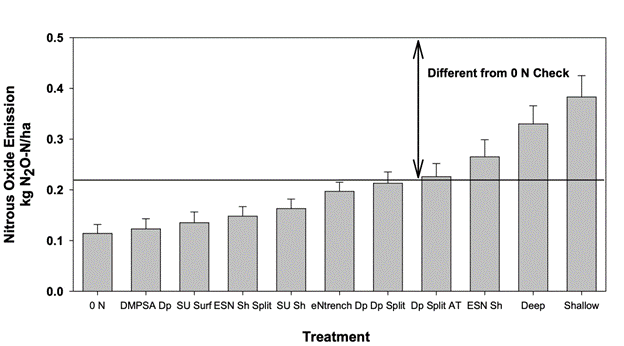Key Result
On light-textured soils, farmers can greatly reduce nitrous oxide emissions (and ammonia losses) from soil by deep-banding urea or using enhanced efficiency fertilizer (EEF) products.
Project Summary
Nitrogen fertilizer is one of the greatest operational costs to producing canola. It can result in production increases, but it can also produce greenhouse gases nitrous oxide (N2O) and ammonia (NH3). For more efficient use of nitrogen fertilizer, reduction in nitrogen losses is required.
Growers are faced with practical challenges of applying nitrogen fertilizer in the fall and uncertainty of whether enhanced efficiency fertilizer products that carry a price premium are worth purchasing. Many growers are also faced with tight schedules for planting are opting to shallow band or even surface place nitrogen fertilizer, though these are not current recommended practices. Some growers are experimenting with in-season nitrogen fertilizer applications but don’t know if it worth the extra management consideration or what rates, application method and fertilizer source to use.
This project aims to provide a solution to mitigate emissions from canola and thus yield losses on light texture soil (the soil most prone to emissions). The project uses combinations of integrated best management practices considering all 4R Nutrient Management components. Reduction of N2O and NH3 emissions from canola production will contribute to achieve the greenhouse gas (GHG) reduction goal for the Canadian agriculture sector and lower the environmental footprint for canola production in Canada.
This project carried out six field trials to help address these grower challenges. It builds upon previous work using 4R Nutrient Management to optimize the rate, source, placement and timing of nitrogen fertilizer addition to canola for improved profitability and reduced greenhouse gas emissions.
Treatments included application timing (fall, spring, and split with spring and in-season), source (urea, SuperU, UAN with Agrotain, urea with eNtrench, urea with DMPSA, and ESN and urea in a 70-30 blend), placement (surface, shallow and deep band), and combinations of all three. Rate for all treatments was 100 per cent of soil test recommendation. A zero nitrogen control was included.
Researchers established the trials on commercial fields in southern Manitoba, targeting light textured soils such as sandy loam. A total of six trial sites were conducted with two sites each for 2019, 2020 and 2021. Trials were not sited on the same location between years to avoid growing canola on canola stubble. InVigor L140P was grown at all sites. All three years of the study were drier than normal.

Results
Enhanced efficiency fertilizers. Urea, whether shallow or deep banded, had the highest cumulative emissions of nitrous oxide. Enhanced efficiency fertilizer products greatly reduced emissions. Treatments SuperU surface applied, SuperU shallow banded, ESN shallow banded and urea plus DMPSA deep banded all had low emissions. Emissions for DMPSA-treated urea and Super U-treated urea specifically were similar to the control treatment with zero added nitrogen.
Deep banding. Researchers applied band treatments with a Bourgault disc-style mid-row bander at 2-2.5cm (1”) or 7.5-10cm (3-4”) depth. For straight urea, the deep band treatment had lower emissions than the shallow banding treatment. Adding an inhibitor reduced losses even further.
Split applications. Split application of urea, with both time-of-seeding and in-crop treatments applied as deep bands, had lower emissions than the single deep application of urea at seeding. Split application where UAN was streamed in-season at rosette stage reduced emissions compared to shallow urea and deep urea at the time of seeding.
Results from this study confirm conclusions from the previous Red River Valley study that nitrification-inhibited urea (single or dual) should be used when shallow banding. Results also confirm that urea with the single nitrification inhibitor treatment can reduce emissions as effectively as dual-inhibited (urease and nitrification) urea.
Read more in the related publication: Placement and nitrogen source effects on N2O emissions for canola production in Manitoba





